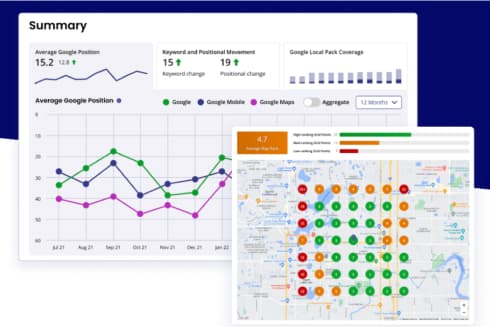SEM: Learn about Search Engine Marketing and How to Use It to Boost Your Brand’s Digital Presence
In today’s digital age, standing out in a sea of competitors can be quite a challenge. This is where Search Engine Marketing (SEM) plays a crucial role. This strategic approach not only helps you increase your brand’s visibility on search engines but also allows you to connect with your target audience effectively and quickly. Unlike other digital marketing techniques, SEM focuses on paid advertising on search platforms like Google Ads, giving you the opportunity to rank your brand high on search results.
SEM is a powerful tool for any business looking for a competitive advantage in the digital environment. Through advertising campaigns specifically designed to appear in search results, you can capture the attention of users who are actively searching for products or services similar to those you offer. This approach not only improves instant visibility, but also facilitates the generation of qualified traffic to your website, which can result in a significant increase in conversions and sales.
One of the main advantages of SEM is its ability to deliver quick results. While SEO (Search Engine Optimization) can take time to show improvements in ranking, SEM campaigns can start generating traffic from the moment they are activated. In addition, SEM allows precise control over the budget, allowing you to adjust bids and investment based on ad performance and campaign objectives. This provides essential flexibility to adapt to changing market needs and maximize return on investment (ROI).
To get the most out of SEM, it’s crucial to conduct thorough keyword research, design engaging and relevant ads, and accurately segment your audience. By doing so, you’ll be able to not only improve your click-through rate (CTR), but also continually optimize your campaigns for the best possible results. In this article, we’ll explore in detail how SEM can transform your brand’s digital presence and offer practical strategies for implementing effective campaigns.
What is SEM?
Search Engine Marketing (SEM) is a digital marketing strategy that focuses on increasing a brand’s visibility through paid advertising on search engines. Unlike SEO (Search Engine Optimization), which seeks to improve a website’s organic ranking, SEM uses ads to place your brand at the top of search results, ensuring immediate exposure to users who are actively searching for related products or services.
Essentially, SEM allows your website to appear in search results by bidding on specific keywords. When a user performs a search that matches those keywords, your ad has the chance to be displayed in a prominent position. This pay-per-click (PPC) advertising method ensures that you only pay when someone clicks on your ad, which can result in highly qualified traffic to your site.
One of the great benefits of SEM is its ability to deliver quick results. While SEO can take months to generate significant improvements in search rankings, SEM campaigns can start attracting visitors to your website almost immediately. Plus, SEM provides detailed control over your budget, allowing you to adjust your bids and strategies based on ad performance and your campaign goals.
To implement an effective SEM strategy, it is essential to conduct thorough keyword research to identify relevant terms that your potential customers are using. Additionally, creating engaging and relevant ads and accurately targeting your audience can significantly improve your click-through rate (CTR) and conversion rate. With proper tracking and analysis, SEM can be a powerful tool to boost your brand’s digital presence and achieve your marketing goals.
Advantages of SEM
- Immediate visibility: Unlike SEO, which can take a while to show results, SEM allows your website to appear in prominent positions in search results almost instantly.
- Budget control: You can adjust and optimize your spending based on ad performance, allowing you to effectively manage cost per click (CPC) and return on investment (ROI).
- Precise targeting: SEM allows you to target your ads to specific audiences based on keywords, location, behavior, and other criteria, increasing the relevance of your campaigns.
- Detailed measurement and analysis: SEM platforms offer advanced tools to track the performance of your ads, providing data on clicks, impressions, conversions, and other key indicators.
- Measurable and adjustable results: You can evaluate the success of your campaigns in real time and make adjustments to improve effectiveness, such as changing keywords or modifying ad content.
- Generating qualified traffic: By targeting users who are actively searching for terms related to your business, SEM helps attract visitors who are more likely to convert.
- Competitiveness: Allows you to compete directly with other businesses in search results, even if you haven’t yet achieved a high position in organic rankings.
- Increased brand awareness: Consistent presence in search results can increase your brand’s visibility and strengthen its recognition in the market.
Disadvantages of SEM
- High cost: Depending on the competitiveness of the keywords, SEM can be expensive. Ads in highly competitive sectors can have a high cost per click (CPC).
- Investment dependency: Unlike SEO, which can generate organic traffic over the long term, SEM requires ongoing investment to maintain visibility. Once you stop campaigns, traffic can quickly decline.
- Complexity in management: Creating and optimizing SEM campaigns can be complex and require specialized knowledge of platforms such as Google Ads. Improper management can lead to poor performance and wasted budget.
- Potential for aggressive competition: In crowded markets, it can be difficult to compete with other advertisers bidding on the same keywords, which can drive up costs and decrease effectiveness.
- Variable click-through rate (CTR): Ad effectiveness can vary, and if ads are not relevant or well-optimized, the click-through rate (CTR) can be low, affecting overall campaign performance.
- Impact on user experience: Intrusive or poorly targeted ads can negatively impact user experience, which could influence brand perception.
- Constant monitoring required: To maximize results, continuous monitoring and adjustment of campaigns is necessary, which can be challenging for businesses with limited resources.
- Results not always guaranteed: Although SEM can offer quick results, it does not always guarantee conversions or sales, especially if the ads are not well aligned with the expectations of the target audience.
Sure, here is the text with main and secondary subtitles about the differences between SEM and SEO:
SEM and SEO: What is the difference?
Introduction to SEM and SEO
In the digital marketing universe, both Search Engine Marketing (SEM) and Search Engine Optimization (SEO) are essential strategies for increasing visibility in search engines. While both aim to improve online presence, their approaches and methods are very different. Understanding these differences can help you choose the right strategy for your marketing goals.
Approach and Method
SEM relies on paid advertising on search engines. This involves placing ads in search results through platforms like Google Ads, where advertisers bid on specific keywords. When users search for terms related to those ads, your ads can appear in prominent positions. This approach allows for immediate visibility and is ideal for generating traffic quickly.
In contrast, SEO focuses on optimizing a website’s content and structure to improve its ranking in search results organically. This includes keyword optimization, improving website structure, and creating relevant content. While SEO can take time to show significant results, its goal is to achieve sustainable visibility without the need to pay for clicks.
Cost and Budget
One of the main factors that distinguishes SEM from SEO is the cost model. SEM requires ongoing investment in paid ads, which can be expensive depending on the competition for keywords. Additionally, the cost can increase if you want to maintain high visibility.
On the other hand, SEO involves initial expenses for website optimization and content creation, but once the website is well positioned, the additional costs are lower. SEO seeks to generate organic traffic in the long term, which can be more profitable as the website gains authority and relevance.
Results and Time
SEM offers fast results, as ads can start appearing in search results as soon as campaigns are activated. This is useful for short-term promotions or for launching new products quickly.
In comparison, SEO is a more gradual process. Improving search engine rankings can take months of continuous work. However, once a website achieves a high position, it can maintain that visibility for longer without the need to constantly pay for ads.
Measurement and Analysis
Both strategies allow for detailed performance measurement, but in different ways. SEM offers real-time data on ad performance, such as clicks, impressions, and conversions, allowing for quick adjustments to campaigns.
SEO, on the other hand, requires a more long-term analysis of traffic and search rankings. Analytics tools provide insight into how users find your website and how they behave once they arrive, helping you make strategic adjustments to improve organic rankings.
12 Key Concepts for Developing a SEM Strategy
- Google Ads is an online advertising platform offered by Google that allows you to create paid advertisements that will be displayed in Google search results or on websites related to the selected keywords.
- Search Terms These are the words or phrases that users enter into the search engine to find information. Choosing the right keywords is crucial to making your ad visible to the right audience. Tools like Google Keyword Planner can help you select relevant terms.
- Ad Sets These are groups of ads that share a common set of keywords. For example, if you run a fashion store and want to promote a new collection of dresses, you can create multiple ads and keywords related to that product line to see which one performs best.
- An advertising campaign is made up of several ad sets. Following the fashion store example, you might have a campaign for dresses, another for pants, and another for tops, each with its own ad set and keywords.
- Advertising Network This is the area where your ads will appear. This can include the top or side of the Google results page, as well as other sites within the Google ecosystem (such as Google Play, Google Shopping, and Google Maps) and on partner sites in the Google Display Network, including YouTube.
- Number of Impressions Refers to the number of times your ads are displayed. Each time your ad appears in search results or on partner sites, it is counted as an impression.
- Number of Clicks This is the number of times users click on your ads. This statistic indicates how attractive your ad is to those who see it and is crucial for evaluating the performance of your campaigns.
- Click Through Rate (CTR) Click Through Rate is the percentage of clicks received in relation to the number of impressions. This metric helps measure the effectiveness and impact of your ads.
- Daily Budget This is the maximum limit that you are willing to spend each day on your advertising campaigns. This budget is completely manageable according to your needs and preferences.
- CPC Bids CPC, or Cost Per Click, is the average price you’re willing to pay for each click on your ads. You can set a maximum CPC to stay within your daily budget. There are options for manual or automatic CPC bidding, with automatic being an option where Google adjusts the maximum CPC to optimize the number of clicks.
- CPM Bidding CPM, or Cost Per Thousand Impressions, is the cost you pay for every thousand times your ad is shown. Unlike CPC, you pay for impressions rather than clicks here, making it an ideal choice if your goal is to increase reach rather than drive direct traffic.
- Quality Score Google’s assessment of the quality of your ads, landing page, and keywords. A higher quality score can result in lower costs and higher rankings in search results.
How to Make a SEM Strategy
Developing an effective SEM strategy requires a planned and detailed approach to ensure that your advertising campaigns create the greatest possible impact. The first step in creating an SEM strategy is to clearly define your objectives. This may include increasing traffic to your website, generating more sales or improving brand awareness. Having clear objectives will help you design more effective campaigns and measure their success.
Next, it’s essential to conduct thorough keyword research. Keywords are critical in determining how and where your ads will be displayed. Use tools like Google’s Keyword Planner to identify relevant terms that your potential customers are searching for. Selecting keywords that align with your audience’s interests and needs is crucial to maximizing the effectiveness of your ads.
Once you’ve defined your keywords, the next step is to create ad groups that focus on those specific terms. Each ad group should be made up of ads that are related to a particular set of keywords. This will allow you to test different messages and approaches to determine which ads resonate best with your audience and which combinations drive the most clicks and conversions.
Budget is another crucial aspect of your SEM strategy. You should set a daily budget that determines how much you are willing to spend on your advertising campaigns. Make sure to adjust this budget based on the performance of your ads and your overall goals. You will also need to decide between CPC (Cost Per Click) and CPM (Cost Per Thousand Impressions) bids depending on your focus, whether it is driving traffic or increasing reach.
After you’ve set up your ads and established your budget, it’s vital to launch your campaigns and monitor their performance on an ongoing basis. Use analytics tools to track key metrics like impressions, clicks, and click-through rates (CTR). This tracking will allow you to make real-time adjustments to optimize your campaigns and improve results.
Finally, conduct regular analysis of your campaigns to assess what’s working and what needs improvement. Adjust your keywords, ads, and budgets based on the data collected to maximize return on investment (ROI). With a constant focus on optimization and adaptation, your SEM strategy can help you effectively achieve your marketing goals.
How to Combine SEM and SEO Strategies
It is clear that both Search Engine Marketing (SEM) and Search Engine Optimization (SEO) are essential to improve your brand’s online visibility and achieve top positions in search engines. Effective integration of SEM and SEO requires that both strategies are aligned with the same objectives and goals. Since SEO often takes time to generate visibility, SEM can complement and accelerate these results.
Timing plays a crucial role in building a complete and successful marketing strategy. Below are some key steps to combine SEM and SEO effectively:
Select the Right Keywords
Keyword research is critical to any search engine strategy. Since every market is unique, it’s important to identify which terms will be most beneficial to your business. Consider your target market and create detailed profiles of your ideal buyers. These profiles, which can include data such as age, gender, occupation, and location, will help you select relevant keywords.
Developing multiple buyer personas will allow you to better segment your products and services. Additionally, researching the keywords your competitors are using can provide you with valuable insights to strengthen your own list of terms. Opt for long-tail keywords and local terms to target specific market segments.
Integrate your Keywords into SEO and SEM
With your list of keywords ready, it’s time to integrate them into both your SEO efforts and SEM campaigns. Make sure to follow SEO best practices when using these keywords, avoiding over-optimization of your site’s content.
Place your keywords in key areas, such as call-to-action (CTA) buttons, and use relevant internal links to improve the authority of your pages. Also, make sure your SEM ads are well-aligned with your selected keywords to maximize their effectiveness.
Monitor and Adjust your Marketing Strategies
SEO and SEM strategies should be dynamic, not static. The digital marketing environment is constantly evolving, which means that both your strategies and tactics need to adapt over time. Regularly monitor your website metrics to assess the effectiveness of your strategies and make adjustments when necessary.
If you’re seeing stagnant conversion rates, it’s crucial to review your strategies and spot potential weaknesses in your sales funnel. Complacency can lead to missed opportunities, so it’s critical to maintain an upward trend and adjust your tactics to ensure continued success.
Maximize your Visibility with SEM
In conclusion, Search Engine Marketing (SEM) is a powerful tool to increase your brand visibility on search engines and reach your target audience quickly and effectively. By implementing well-planned strategies and aligning your SEM campaigns with your marketing goals, you can achieve significant results, from traffic generation to improved conversions. However, it is crucial to continuously monitor and adjust your campaigns to maximize their impact and maintain a competitive advantage in the dynamic digital landscape. With proper execution, SEM can be a key component in your overall marketing strategy, complementing other tactics such as SEO to achieve a robust and successful online presence.












